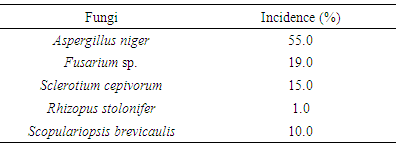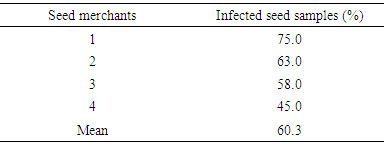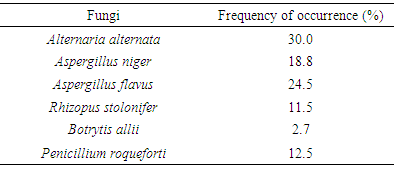-
Paper Information
- Paper Submission
-
Journal Information
- About This Journal
- Editorial Board
- Current Issue
- Archive
- Author Guidelines
- Contact Us
International Journal of Modern Botany
p-ISSN: 2166-5206 e-ISSN: 2166-5214
2016; 6(2): 26-30
doi:10.5923/j.ijmb.20160602.02

Identification of Fungi Associated with Storage Bulb Rot and Seed of Onion (Allium cepa L.) in Maiduguri, Northeastern Nigeria
M. B. Jidda, F. Benjamin
Department of Crop Protection, University of Maiduguri, Nigeria
Correspondence to: M. B. Jidda, Department of Crop Protection, University of Maiduguri, Nigeria.
| Email: |  |
Copyright © 2016 Scientific & Academic Publishing. All Rights Reserved.
This work is licensed under the Creative Commons Attribution International License (CC BY).
http://creativecommons.org/licenses/by/4.0/

Northeastern part of Nigeria, particularly, Borno State is one of the major producers of onion but the bulk of which is lost to storage rots which are attributed to poor handling and/or storage pathogens. Laboratory experiment was carried out on thirty samples each of two varieties (Monguno White and Monguno Red) of rotten onion bulbs collected from different stores at Gamboru vegetable market, Maiduguri, Borno State to identify the types of fungal species associated the spoilt onion bulbs and those associated with seed collected at random from four different seed merchants (sellers). The fungi commonly isolated from both Monguno White and Red varieties were Aspergillus niger and Fusarium sp.while Sclerotium cepivorum, Rhizopusstolonifer and Scopulariopsisbrevicauli were isolated from theaffectedwhitebulbsonly.Two yeasts: Candida tropicalis and Saccharomycescerevisiae were only isolated from the Red variety. A. niger was the most frequently isolated fungi from both Monguno White and Red bulbs. The least encountered fungi were R.stolonifer and S. cerevisiae in White and Red bulbs, respectively. The Blotter method was used to assess the presence of fungi on seed samples of Monguno Red variety. More than 60% of the seed samples were associated with various species of fungi. The most frequently isolated species were A. flavus and A. niger which together contaminated more than 43% of the seed samples. A. alternata was associated with about 30% of the seed samples. The least percentage (2.7) contamination of the seed samples was by Botrytis allii. Selection of clean disease free seeds and seed treatment with appropriate fungicides before planting; careful and proper handling of bulbs during and after harvest will help reduce incidences of field and storage diseases.
Keywords: MongunoWhite bulbs, Red bulbs, Storage rots, Seed-Borne, Fungi, Seed merchants
Cite this paper: M. B. Jidda, F. Benjamin, Identification of Fungi Associated with Storage Bulb Rot and Seed of Onion (Allium cepa L.) in Maiduguri, Northeastern Nigeria, International Journal of Modern Botany, Vol. 6 No. 2, 2016, pp. 26-30. doi: 10.5923/j.ijmb.20160602.02.
Article Outline
1. Introduction
- The northeastern part of Nigeria, particularly, Brono State is major producer of onion, which is an important vegetable crop used daily in diet for seasoning and flavouring of a wide variety of food. Onion is cultivated in Bama, Dikwa, Marte, Monguno, and Damasak local Government Areas of Borno State. It is mainly cultivated as cash crop during dry season (September to March). Most onion farmers in this region sell off their harvest to vegetable dealers/merchants stationed in major towns of the state, particularly Maiduguri, the state capital. These dealers do not readily sell the crop due to low onion price at the time of harvest. The onion is kept in large stores to be sold to city consumers in piecemeal but others are kept for months until when the fresh supplies are limited and prices are higher. During storage, losses are encountered due to sprouting, drying and rotting [7]. However, the most common factor responsible for loss of onions in storage is from bulb rots [27] which contribute to 10-60% of storage losses [22, 30]. Bulb rotting is caused by a number of storage pathogens. Among them, fungi are the major causal agents responsible for storage losses [3, 4, 21, 24, 25, 26, 27].Some of these storage fungi are also seed borne. Those isolated from onion seeds included Fusarium oxysporum, F. solani, F. moniliforme, F. avenaceam, F. poae, F. verticilloides, Rhizoctonia solani [1, 3], Alternaria alternata, A. porri ([31], Botrytis allii, Aspergillus niger, A. flavus and A. fumigates [3, 8, 14, 15], Penicillium spp., Rhizopus nigricans, Trichoderma sp., Mucor sp., Colletotrichum circinam [20] and Curvularia sp., Drechslera sp. (Dumbre [9]. Their presence on seed had been responsible for reduced seed viability, pre- and post- emergence mortality [11], black mould [16]), neck rot and basal plate rot on onion bulbs [29, 28]) and poor health of seeds in many crops [23]. Farmers in the northeastern part of Nigeria use their own saved seeds for cultivation or those produced by other farmers from other parts of the country that are not certified disease free but possibly contaminated. Such seeds could serve as carriers and transmitters of fungal diseases both in storage and in the field. Abdulsalam et al. [2] reported the presence of some fungi associated with onion neck rot in Bama Local Government Area of Borno State. However, there is little or no studies conducted on the types of fungi associated with storage rots and seed of onion. The present study was, therefore carried out to identify and determine the incidence of seed-borne fungal pathogens of onion and those associated with rotten onion bulbs collected from some stores in Gamboru vegetable market in Maiduguri Metropolitan Council, the Borno State capital.
2. Materials and Methods
- The laboratory assessment for the identification of the fungal pathogens was conducted at the Plant Pathology Laboratory, Department of Crop Protection, University of Maiduguri, Nigeria during the months of October to December, 2008.
2.1. Collection of Samples
- For the bulb rot assessment, two onion bulb varieties (Monguno Red and Monguno White) were sampled. Thirty bulbs from each variety showing symptoms of rot and discolouration were randomly collected from different stores at the vegetable market in Maiduguri. Seed samples of Monguno red variety were randomly collected from four different seed merchants at Gamboru vegetable market in Maiduguri, Borno State, Nigeria. Fifty grams of seed samples were collected from each merchant to assess the presence and the level of contamination of seeds by fungal pathogens.
2.2. Isolation and Identification of Rot Inducing Fungi
- Two onion bulb varieties (Monguno Red and Monguno White) were used for detection of the pathogens responsible for the rots on the affected onion bulbs. The bulbs were stripped of their outer dry scales and surface sterilized in 1% commercial bleach for one minute. These were then rinsed in three successive changes of sterile distilled water and blotted dry with sterile filter paper. Small segments of tissues (3mm3) from the advancing margins of rotted lesions and the healthy tissues were cut out with a sterile scalpel and forceps, and plated on acidified potato dextrose agar (PDA) in 90 mm Petri dishes. The plates were incubated at room temperature (28 ± 3°C) for seven days. Developing fungal colonies were sub – cultured continuously on fresh PDA plates to obtain pure cultures of the isolates. Fungal isolates were identified based on cultural and morphological characteristics [6, 17].
2.3. Isolation and Identification of Seed-borne Fungi
- Blotter method was used for the detection of fungi associated with Monguno Red onion seeds following the International Rules for Seed Testing Association [18]. In this method, two layers of filter paper (Whatman No. 1) were moistened with sterilized water and placed at the bottom of 9.0 cm diameter plastic Petri dishes. Four hundred seeds were taken at random and divided into two batches. The first batch of two hundred Seeds was surface sterilized by soaking in 10% commercial bleach for two minutes and rinsed immediately with sterile distilled water. The second batch of two hundred seeds was unsterilized. All the seeds were then placed on the moist filter paper in twenty Petri dishes at the rate of 20 seeds per plate. After plating, the seeds in the Petri dishes were then incubated at 22±2°C under 12/12 h alternating cycles of 12 h light and 12 h darkness NUV light and darkness for seven days. At the end of the incubation period, the seeds were examined under the stereo microscope for the presence of seed-borne fungi on the incubated seeds. Fungi were identified by comparing the observed characteristics of the colony as well as the vegetative structures with the description in the standard reference books: Description of fungi and bacteria (IMI, 1992). The fungal species present on each seed were recorded and the percentage incidence of each fungus was computed.
3. Results
- Sixty percent of the rotten tissues of the Monguno Red onion bulbs collected from different stores at Gamboru vegetable market Maiduguri contained Aspergillus niger and 20% contained Fusarium sp. (Table 1). Two yeast species: Candida tropicalis (17%) and Saccharomyces cerevisiae (3.0%) were also found on the affected Red onion bulbs.
|
|
|
|
4. Discussion
- The present study showed that A. niger, Fusarium sp., S. cepivorum, R. stolonifer, S. brevicaulis, C. tropicalis and S. cerevisiae were associated with both Monguno Red and White onion bulb rot collected from Gamboru vegetable market, Maiduguri. Similar findings were reported by Rajapakse and Edirimanna [25], Ara et al. [4], Shehu and Muhammad [27] and Adongo et al. [3] except the presence C. tropicalis and S. cerevisiae. However, they have reported the presence of A. flavus, A. fumigatus, Alternaria porri, Colletotrichum sp. and Penicillium spp. in the rotten tissues of onion bulbs they examined in addition to the fungal species isolated in this study. Samuel and Ifeanyi, [26] had reported the presence of S. cerevisiae on spoilt onion bulbs but had the least percentage distribution.A. niger was the most frequently isolated fungi from the rotten Monguno Red and White bulbs. This is in agreement with the findings of Ara et al. [4], Shehu and Muhammad [27], Abdulsalam et al. [2], Adongo et al. [3] and Samuel and Ifeanyi, [26]. A.niger was the most virulent fungal pathogen in the field and during the post harvest storage [21], and was the most important pathogen responsible for black mould of onion during storage [16, 19, 32]. Other fungal genera such as Penicillium, Alternaria, Rhizopus and Aspergillus were reported [3, 27] to be pathogenic in inducing bulb rots in onion. The fungi associated bulb rot caused about 15- 30% losses during storage of different varieties [21]. The study has found that more than 60% of the Monguno Red onion seeds samlpes collected from four different seed merchants at Gamboru vegetable market, Maiduguri were infected by fungi. The fungal pathogens isolated in decending order of percentage frequency were A. alternata, A. flavus, A. niger, P. roqueforti, R. stolonifer and B. allii. Similar fungal species were also isolated by Aveling et al. [5], Dumbre et al. [9] and Adongo et al. [3] except the genera Fusarium, Curvularia and Drechslera that were not found on onion seeds under study. Individual fungal isolates from the onion seeds in this study showed that A. alternata was the most frequent fungal species encountered on the seeds. This differed from the findings of Aveling et al. [5], Köycü and Özer [20], Dumbre et al. [9]) and Adongo et al. [3] who reported A. niger to be the most frequently encountered fungi among the onion seeds tested. However, the genus Aspergillus occurred most often on the onion seeds in the present study agreed with the findings of El-Nagerabi and Abdalla [12]) that isolated the genus from most of the onion seed samples they examined in Sudan.Seeds are regarded as sources responsible for transmission of pathogens and hence the diseases of many crops. The presence of A. Niger and F. verticilloides on onion seeds prevented the development of root and shoot due to pre-emergence damping-off [1, 13], A. Niger caused Black mould diseases [16] also reduced seed germination, seedling emergence and vigour [10, 20]. Seed-borne Botrytis spp., Fusarium spp., Alternaria porri and Rhizopus stolonifer were responsible for neck rot disease, basal plate rot, purple blotch of onions, and mushy rot on onion bulbs [20, 28, 29]. The presence of similar fungi on both seed and rotten bulbs in the present study suggests the transmission of these fungi from the field to store and vice versa. The production of onion and its storage are therefore influenced by the presence of seed-borne fungi.
5. Conclusions
- More than 70% of the spoilt bulbs assessed contained A. niger and Fusarium sp. While more than 60% of the seed samples collected from different seed sellers at Gamboru vegetable market, Maiduguri were contaminated with various species of fungi. The most frequently isolated species were A. flavus and A. niger which together contaminated more than 43% of the seed samples. A. alternata was associated with about 30% of the seed samples The presence of large numbers these fungi on both seed samples and rotten bulbs suggests the possibility of the fungus being transmitted through the seed to the field and later serve as agents of storage diseases. Since farmers rely on the seed sellers for their supply, selection of clean disease-free seeds, seed treatment with appropriate fungicides before planting; careful and proper handling of bulbs during and after harvest will help reduce incidences of field and storage diseases.
ACKNOWLEDGEMENTS
- We are grateful to Mr. J. Bitrus, the Senior Laboratory Technologist, for his advice and technical assistance in setting and completing of the experiment.
 Abstract
Abstract Reference
Reference Full-Text PDF
Full-Text PDF Full-text HTML
Full-text HTML


